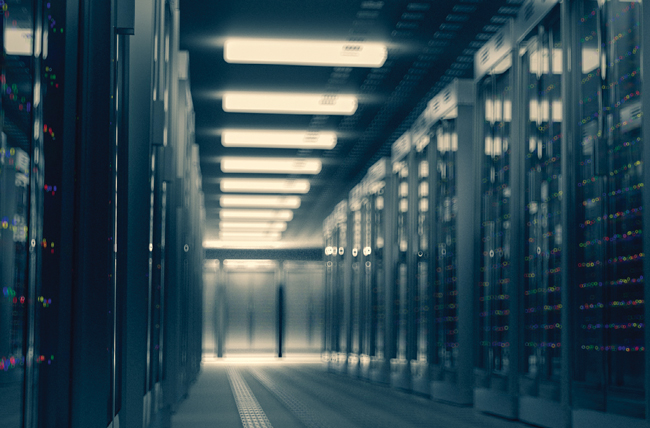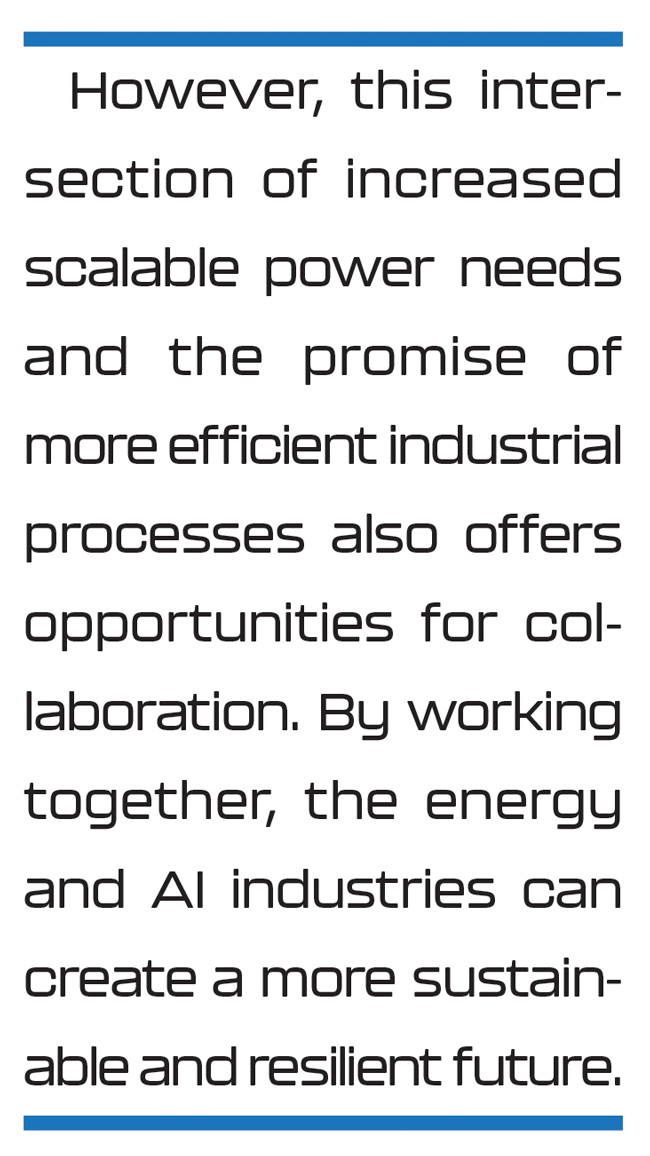
Energy And AI Sectors Approaching Crossroads As Data Center Demand Grows
By Geoff Bland
JERSEY VILLAGE, TX.—The world stands at the precipice of a new industrial revolution powered by artificial intelligence. As AI’s influence and capabilities grow, so does its insatiable demand for computational power, significantly increasing the energy needs of data centers. At the same time, stringent environmental regulations are compelling the oil and gas industry to shift toward more sustainable, electric-driven solutions. This intersection creates a complex and challenging landscape where AI may emerge as both a major customer and a fierce competitor for energy resources.
Historically, the energy sector has been dominated by oil and gas. These traditional energy sources have powered global economies for decades. However, policies to combat climate change have led to a substantial push toward renewable energy sources such as wind, solar and hydroelectric power. Despite the impetus for this shift, it has not been accompanied by sufficient investment in dispatchable power generation—plants that can provide electricity quickly to meet demand when renewable sources are insufficient.
Recent studies estimate that data centers already account for about 1% of global electricity consumption. As AI applications become more prevalent, this percentage is expected to rise significantly. The training of advanced AI models, in particular, is extremely energy intensive. For instance, training a single AI model can consume as much electricity as a small town over several months.
According to one published study, generating sufficient power for data centers will add 2.5 billion cubic feet a day of new U.S. gas demand during the next five years. Other studies forecast even greater new incremental gas demand to supply AI-driven data center growth across the country.
There is no doubt the AI industry is experiencing explosive growth. Data centers, which form the backbone of AI operations, consume vast amounts of energy to power and cool the banks of servers running complex algorithms. From cloud computing to machine learning, the proliferation of AI-driven services has dramatically increased the demand for reliable and scalable power solutions.
As AI technologies advance, the computational power requirements grow exponentially. Training sophisticated AI models can consume as much energy as hundreds of homes during the course of a year. This surge in energy consumption by data centers is putting additional strain on an already stressed power grid.
Regulations And Supply Chain
The U.S. Environmental Protection Agency has introduced stringent new regulations that mandate carbon capture for any new baseload generation plants. These regulations introduce significant challenges for the energy industry. Implementing carbon capture technology is both costly and technologically complex, adding substantial time and financial burdens to new power generation projects.
Compounding these challenges is the strained supply chain for power generation equipment. During the past few years, the global supply chain has faced a variety of disruptions, including the Covid-19 pandemic, geopolitical tensions, raw material shortages, and shipping and transportation bottlenecks. These disruptions have extended lead times for critical power generation equipment such as turbines, transformers and carbon capture systems.
The lengthening lead times for this equipment now often are measured in years. The extended wait between when an order is placed and when the equipment is received makes it increasingly difficult for new projects to come on line promptly. For example, securing a new gas turbine previously took several months, but now can take two years or longer. This delay not only hampers the ability to meet growing power demand, but also complicates compliance with the new EPA regulations.
The strain on the supply chain has several ripple effects, including:
- Increased costs, with the scarcity of equipment and longer lead times driving up bottom-line costs and making new power generation projects more expensive and less economically viable;
- Project delays associated with the lengthy lead times impacting the scheduling and commissioning of new plants, exacerbating the current underinvestment in dispatchable power generation and potentially leading to power shortages; and,
- Technological bottlenecks and stalled innovations in power generation and carbon capture technologies attributable to the unavailability of necessary components, hindering progress toward cleaner energy solutions.
These supply chain challenges highlight the urgent need for strategic planning and investment in the energy sector. To navigate this complex landscape, industry stakeholders must collaborate to streamline the supply chain, invest in domestic manufacturing capabilities and explore alternative technologies that can reduce dependence on strained resources.
Rising Demand
As the AI industry continues to grow, its power demands are poised to increase at an unprecedented rate. Data centers are at the heart of this growth, and they require massive amounts of electricity to operate efficiently. Data centers’ energy consumption is not only about running the servers; it also includes cooling systems to maintain optimal operating temperatures.
This rise in energy demand from AI is occurring at a time in which the power grid is already under various forms of pressure. Intermittent renewable energy sources such as wind and solar cannot always provide a steady supply of electricity. This intermittency creates a need for dispatchable power generation to fill in the gaps, but underinvestment in such infrastructure has left many regions vulnerable to power shortages.
The AI industry’s increasing energy needs are exacerbating the power grid’s existing challenges. Without substantial investments in new power generation capacity and infrastructure, it will become increasingly difficult to meet the growing demand for electricity from both traditional and emerging industries.
Potential Conflict
The intersection of these trends lends itself to a potential conflict. The energy industry is moving toward decarbonization and electrification, while the AI industry’s power demands are skyrocketing. This scenario is reminiscent of the mythological Ouroboros, a serpent eating its own tail, symbolizing a cycle of self-destruction. If not managed carefully, the competition for power can hinder both sectors’ future growth and vitality.
Today, data centers consume about 1% of the world’s electricity. As artificial intelligence matures and gains popularity, their strong appetite for energy may lead to a significant increase in power demand, which is likely to create competition for power generation equipment that could complicate the oil and gas industry’s efforts to electrify its operations. However, any complications likely will come alongside a notable boost to natural gas demand.
However, this intersection of increased scalable power needs and the promise of more efficient industrial processes also offers opportunities for collaboration. AI can be leveraged to optimize energy usage, improve grid management and enhance the efficiency of renewable energy sources. By working together, the energy and AI industries can create a more sustainable and resilient future.
AI has the potential to revolutionize energy management. Advanced AI algorithms can predict energy demand with greater accuracy, optimize the dispatch of power plants and manage the integration of renewable energy sources into the grid. These capabilities can help alleviate some of the strain on the power grid and make it more adaptable to supply and demand fluctuations.
For example, AI can be used to forecast energy consumption patterns based on historical data and real-time inputs. This allows grid operators to better anticipate demand peaks and troughs and adjust their operations accordingly. AI also can optimize the performance of renewable energy sources by predicting weather patterns and adjusting the output of solar panels and wind turbines in real time.
In addition to these operational improvements, AI can play a crucial role in enhancing the efficiency of energy consumption. AI-powered smart grids can balance supply and demand dynamically, reducing waste and improving the overall efficiency of the power system. Energy management systems enabled by AI also can help consumers optimize their energy use, which lowers costs and reduces environmental impact.
The Path Forward
Navigating the challenges and opportunities presented by the intersection of AI and the energy industry requires a multifaceted approach. Policymakers, industry leaders and researchers must work together to develop solutions that address both sectors’ immediate and long-term needs.
Investment in new power generation capacity is crucial. This includes not only renewable energy sources, but also dispatchable power generation that can provide a reliable supply of electricity when renewable sources are unavailable. Policymakers should incentivize the development of such infrastructure through subsidies, tax credits and other financial mechanisms.
At the same time, there must be a concerted effort to address the supply chain challenges that currently hamper the deployment of new power generation equipment. This may involve diversifying the supply chain, investing in domestic manufacturing capabilities and developing new technologies that are less dependent on scarce resources.
Collaboration between the AI and energy sectors will be essential to creating a more sustainable and resilient power system. Industry leaders should seek partnerships and joint ventures that leverage both sectors’ strengths. For example, AI companies can work with energy providers to develop AI-driven solutions for grid management and energy optimization.
Research and development also will play a critical role in addressing these challenges. Continued innovation in AI and energy technologies will be necessary to overcome today’s technical and economic barriers. Governments and private sector organizations should increase funding for R&D initiatives that focus on sustainable energy solutions and AI applications in the energy sector.
The convergence of environmental regulations and the rising energy demands of AI presents both challenges and opportunities. The energy industry must navigate these changes carefully to avoid a scenario that undermines its progress. At the same time, the AI industry needs to be mindful of its growing carbon footprint. By fostering collaboration, both industries can thrive in this new era of innovation.
The future of the energy industry will be shaped by how well it adapts to the changing landscape. As AI continues to grow and evolve, its impact on the power grid is likely to become increasingly significant. Much like the story of the serpent eating its own tail, AI potentially may consume the very power required to extract the fuel it needs. By working together, the AI and energy industries can ensure that they both continue to grow and prosper, creating a more sustainable and resilient future for all.

GEOFF BLAND is vice president of business development at Jersey Village, Tx.-based Life Cycle Power, which provides high-power-density turbine microgrid solutions. Before joining Life Cycle Power, he served for 15 years as global power products manager at Aggreko, where he played a pivotal role in developing power projects across 62 countries. Bland holds an engineering degree from Glasgow University and a master’s from Cambridge University.
For other great articles about exploration, drilling, completions and production, subscribe to The American Oil & Gas Reporter and bookmark www.aogr.com.








